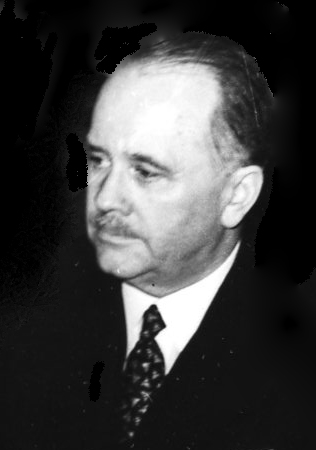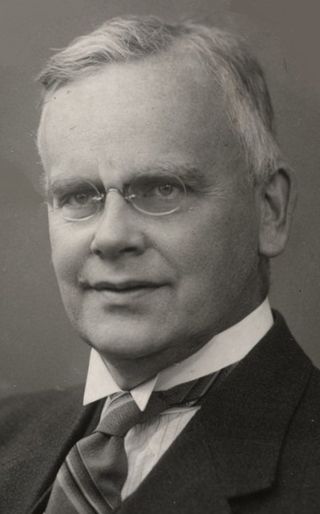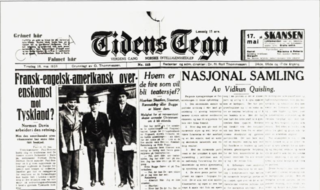Related Research Articles

Gulbrand Oscar Johan Lunde was a Norwegian chemist and politician of the Nasjonal Samling party who became a minister in the collaborationist government of Vidkun Quisling during World War II. His 1942 death was deemed accidental, although a 2012 biography of Lunde concluded that he was assassinated because his cultural views clashed with those of the government of Nazi Germany.

Erling Sandberg was a Norwegian banker and politician.

Ernst Josef Albert Weiner was a German SS-Hauptsturmführer during World War II. He was most noted for his role in Operation Blumenpflücken during the occupation of Norway by Nazi Germany.
Albert Wiesener was a Norwegian lawyer.
Johannes Sigfred Andersen was a Norwegian resistance fighter during the Second World War, a member of the Norwegian Independent Company 1 (NOR.I.C.1). He was nicknamed "Gulosten"; 'The Yellow Cheese'. He also used the surname Ostein during the war. Andersen was a controversial character, because of his pre-war life as a well-known career criminal and a series of incidents that occurred during the war years. These incidents included Andersen working as an assassin during the war, and shortly after the war killing two German prisoners of war during a drinking binge. After the war, Andersen started a wood furniture business. He was supported financially by King Haakon VII of Norway, whose friendship he had gained during the war. Andersen was repeatedly accused of crimes after the war, and on one occasion convicted.

Hans Fredrik Dahl is a Norwegian historian, journalist and media scholar, best known in the English-speaking world for his biography of Vidkun Quisling, a Nazi collaborationist and Minister President for Norway during the Second World War. His research is focused on media history, the totalitarian ideologies of the 20th century, and the Second World War. He served as culture editor of Dagbladet 1978–1985 and has been a board member of the paper since 1996. He was a professor at the University of Oslo 1988–2009, and is now a professor emeritus.

Harald Gram was a Norwegian jurist, politician and genealogist. He was secretary general for the Conservative Party of Norway for 22 years, deputy mayor of Aker, member of Parliament from 1928 to 1936, and stipendiary magistrate in Oslo from 1936 to 1957. He was also noted for his work during World War II.

Tidens Tegn is a former Norwegian newspaper, issued in Oslo from 1910 to 1941.

The Quisling regime, or Quisling government are common names used to refer to the fascist collaboration government led by Vidkun Quisling in German-occupied Norway during the Second World War. The official name of the regime from 1 February 1942 until its dissolution in May 1945 was Den nasjonale regjering. Actual executive power was retained by the Reichskommissariat Norwegen, headed by Josef Terboven.
The 1943 University of Oslo fire was a fire in the ceremony hall of the University of Oslo in 1943. Its direct consequences were the closing of the university, and the arrest of 1,166 people; these were chiefly male students. Of these, 644 were sent to German "readjustment" camps, where 17 people died. Initial beliefs that the fire was either a Reichstag fire or perpetrated by communists were wrong; members of the Norwegian resistance movement were responsible.

Helge Krog was a Norwegian journalist, essayist, theatre and literary critic, translator and playwright.
Roald Rachlew Dysthe was a Norwegian businessperson and acquitted Nazi collaborator.
Finn Hannibal Kjelstrup was a Norwegian military officer.
Erling Olsen (1901–1983) was a Norwegian trade unionist.
Operation Blumenpflücken was a counter-resistance operation in occupied Norway, planned and carried out by the Gestapo/Sicherheitspolizei in 1944 and early 1945.
Odd Erling Melsom was a Norwegian military officer and newspaper editor.

Fritt Folk was a Norwegian newspaper, published in Oslo. It was the official organ of the fascist party Nasjonal Samling, and came to prominence during the Second World War.
Johannes Kringlebotn was a Norwegian newspaper editor. He edited Folketanken and, during the Nazi era in Norway, Stavanger Aftenblad. After serving a treason sentence he returned in the 1950s to edit the historical revisionist newspaper Folk og Land. He was involved in politics and organizational life in the interwar period, and was also among Norway's top-ten middle distance runners.

Georg Eugen Nielsen was a Norwegian architect, publisher and activist.
Arbeideren was a daily newspaper published in Oslo, Norway.
References
- 1 2 3 4 Øvsthus, Georg (1995). "Folk og Land". In Dahl, Hans Fredrik (ed.). Norsk krigsleksikon 1940-45 . Oslo: Cappelen. Archived from the original on 15 March 2012. Retrieved 22 July 2010.
- 1 2 3 4 5 6 7 Dahl, Hans Fredrik (2010). "Folk og Land". In Flo, Idar (ed.). Norske aviser fra A til Å. Volume four of Norsk presses historie 1660–2010 (in Norwegian). Oslo: Universitetsforlaget. p. 116. ISBN 978-82-15-01604-7.
- ↑ Pryser, Tore. "Odd Erling Melsom". In Helle, Knut (ed.). Norsk biografisk leksikon (in Norwegian). Oslo: Kunnskapsforlaget. Retrieved 22 July 2010.
- 1 2 Moland, Arnfinn (1999). Over grensen? (in Norwegian). Oslo: Orion. p. 35. ISBN 82-458-0337-5.
- ↑ Moland, 1999: p. 348
- ↑ Moland, 1999: p. 95